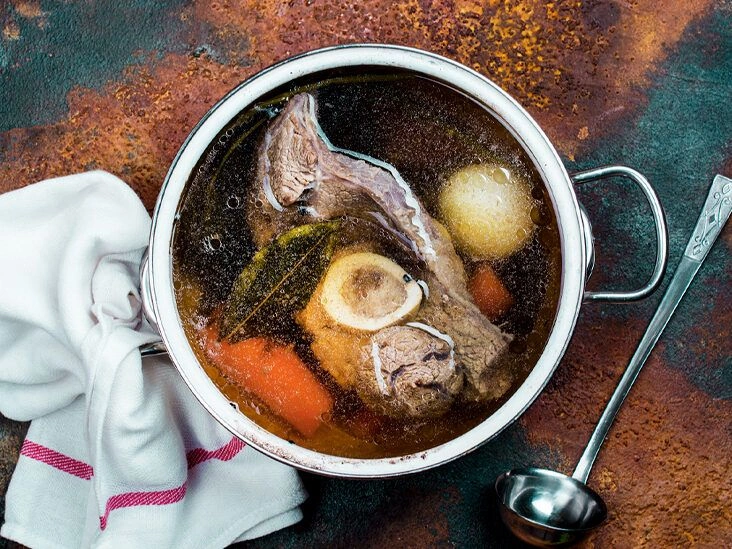Bone broth may offer a variety of nutritional advantages. It’s nutrient-dense and might support bone health, aid digestion, and provide other wellness benefits.
Although direct research on bone broth’s effects is limited, substantial evidence indicates the nutrients it supplies can be beneficial to health.
This article examines bone broth more closely, shares a simple method for preparing it, and outlines its possible health benefits.

What is bone broth?
Bone broth is created by simmering animal bones and connective tissues for an extended period.
The resulting liquid is used as a base for soups, sauces, and gravies, and can also be consumed as a nourishing beverage.
Bone broth has roots in prehistoric times, when early hunter-gatherers converted parts of animals that were otherwise inedible—like bones, hooves, and knuckles—into a drinkable broth.
You can make bone broth from the bones of nearly any animal—chicken, pork, beef, veal, turkey, lamb, bison, buffalo, venison, or fish.
Bones rich in marrow and connective tissue—such as feet, hooves, beaks, gizzards, or fins—are also commonly used.
How to make bone broth
Preparing bone broth is straightforward. There are numerous recipes available, though many people simply improvise.
All you really need is a large pot (or slow cooker), water, vinegar, and bones.
To help you begin, here’s an easy recipe to follow:
Ingredients
- 1 gallon (4 liters) water
- 2 tbsp (30 mL) apple cider vinegar
- 2–4 pounds (about 1–2 kg) animal bones
- Salt and pepper, to taste
Directions
- Put all ingredients into a large pot or slow cooker.
- Bring the mixture to a boil.
- Lower the heat to maintain a simmer and cook for 12–24 hours. Longer cooking enhances flavor and extracts more nutrients.
- Let the broth cool, then strain it into a large container and discard the solids.
To boost nutrition, use a mix of bones—marrow bones, oxtail, knuckles, and feet work well.
Adding vinegar is key because it helps draw minerals and other valuable compounds from the bones into the liquid you’ll consume.
You may also include vegetables, herbs, or spices to enhance flavor; common additions are garlic, onion, celery, carrot, parsley, and thyme. Add these at the start of cooking.
What are the benefits of bone broth?
1. It contains vitamins and minerals
Bone broth can provide nutrients, though the exact nutrient profile varies depending on the bones used.
- Animal bones supply calcium, magnesium, and other vitamins and minerals that help build and strengthen human bones. Nevertheless, only modest amounts—often under 5% of the daily value—typically make it into the broth.
- Marrow contributes minerals such as calcium and phosphorus and trace amounts of vitamins A, B, K, and E.
- These components also contain collagen, which converts to gelatin during cooking and provides several relevant amino acids.
Simmering releases some of these nutrients into the water in forms that are more readily absorbed by the body.
Are collagen or gelatin supplements better?
2. It may benefit the digestive system
A healthy digestive tract is vital to overall wellness.
Bone broth is easy to digest and may help lower inflammation within the digestive tract.
Animal studies involving colitis suggest gelatin may help protect and repair the mucosal lining of the gut, though more human research is needed to confirm this.
Gelatin contains the amino acid glutamic acid, which converts to glutamine in the body and supports intestinal wall function. This may help prevent and heal “leaky gut,” a phenomenon associated with several chronic gastrointestinal conditions.
Leaky gut refers to damage to the barrier between the gut and the bloodstream, allowing substances to pass into the circulation and potentially triggering inflammation and other issues.
Research has also suggested the amino acids in bone broth possess anti-inflammatory effects that might reduce gut damage from conditions like ulcerative colitis.
For these reasons, drinking bone broth may be helpful for people with various digestive disorders.
Get more tips on managing gut inflammation.
3. It may help fight inflammation
Amino acids present in bone broth, such as glycine and proline, have anti-inflammatory properties.
For example, a 2015 animal study showed that oral arginine reduced airway inflammation and other asthma symptoms in mice.
However, human trials have been mixed. One study found arginine supplementation did not lower inflammatory markers like CRP and TNF-alpha, and another reported arginine increased CRP in participants over 60. More research is clearly needed.
Chronic inflammation contributes to many serious illnesses, including heart disease, diabetes, arthritis, and cancer.
Integrating anti-inflammatory foods into the diet—bone broth among them—may help lower the risk of these conditions.
How do you begin an anti-inflammatory eating plan?
4. Its nutrients may improve joint health
Collagen is the main protein in bones, tendons, and ligaments.
During the cooking of bone broth, collagen from bones and connective tissue breaks down into gelatin.
Gelatin supplies amino acids that support joint health.
These include proline and glycine, which the body can use to synthesize its own connective tissue. Connective tissue is a major component of tendons (which connect muscle to bone) and ligaments (which connect bone to bone).
However, the levels of these amino acids in bone broth are typically much lower than the “therapeutic” amounts found in concentrated supplements.
Which supplements can help with joint discomfort?
5. Weight management and muscle mass
Bone broth is relatively low in calories while still being filling.
Evidence suggests people who regularly consume soups tend to have lower rates of obesity, indicating soups may assist in weight control.
Bone broth is also a source of protein, and research suggests higher-protein diets can aid weight management by increasing satiety.
In 2023, a placebo-controlled trial involving 74 older adults found a significant reduction in body fat mass in the group taking collagen supplements compared to the control group.
However, a 2019 review noted bone broth is unlikely to provide collagen amounts comparable to those in supplements. Additionally, collagen content and quality in homemade broth can vary more than in standardized supplements.
What does a weight-loss strategy look like?
6. It may improve sleep and brain function
The amino acid glycine, present in bone broth, may promote relaxation. Some research indicates glycine can support better sleep.
An older study found that taking 3 grams of glycine before bedtime significantly improved sleep quality in people with insomnia.
Participants who took glycine before bed experienced:
- faster sleep onset
- deeper sleep maintenance
- fewer nighttime awakenings
The study also reported reductions in daytime sleepiness and improvements in cognitive function and memory.
Drinking bone broth may offer similar effects.
However, the glycine content of a 1-cup serving of bone broth varies—about 500–1700 mg (0.5–1.7 g)—so you might need 2–6 cups to reach the 3 g dose used in the study.
Get tips for sleeping better.
Tips for using bone broth
Below are practical suggestions for making and storing bone broth and using it in meals.
Where to get bones
Save leftover bones and carcasses rather than discarding them; they are perfect for making broth.
Collect bones in a bag and freeze them until you’re ready to cook.
If you don’t usually buy whole chickens or bone-in cuts, ask your local butcher or farmers’ market—most grocery meat departments will also have bones available.
Bones are generally inexpensive, and sometimes butchers will give them away for free.
How to store broth
Making broth in large batches is convenient, but it can be kept safely in the refrigerator for 3–4 days.
If you want to keep it longer, freeze portions in small containers and thaw single servings as needed.
Ways to eat it
If you’re not fond of drinking bone broth straight, use it as a base for soups, stews, sauces, or gravies.
Here’s a straightforward tomato sauce recipe made with bone broth.
Ingredients
- 2 cups (473 mL) bone broth
- 2 cans organic tomato paste
- 2 tbsp (30 mL) extra virgin olive oil
- 1/2 tsp (2.5 mL) oregano, chopped
- 1/2 tsp (2.5 mL) basil, chopped
- 2 cloves garlic, minced
- Salt and pepper, to taste
Directions
- Combine all ingredients in a medium saucepan.
- Heat over medium-high heat for 4–6 minutes, stirring occasionally.
- Lower to a gentle simmer, cover, and cook for an additional 5 minutes.
- Serve over pasta, meatloaf, or use in other recipes.
Where to buy it
If you don’t have time to prepare bone broth, you can purchase organic and other varieties from health food stores, supermarkets, and online retailers.
Frequently asked questions
What are the benefits of bone broth?
Bone broth is rich in protein and other nutrients. It may support digestive health, help maintain muscle and bone, and be useful in weight management plans.
Are there any downsides or side effects?
If the animal bones used are from unhealthy sources, that could affect broth quality.
In 2017, researchers investigated whether bones used for broth might contain harmful levels of toxic metals like lead and concluded that detected levels were too low to pose a health risk.
It’s important to follow the same food-safety guidelines for purchasing, storing, preparing, and handling bones and bone broth to reduce risk of bacterial contamination or infection.
Get some tips here on meat safety.
How often should you drink bone broth?
Frequency depends on personal preference. Some people drink one cup (237 mL) daily, while others use it occasionally as the base for soups or stews.
Can bone broth help you lose weight?
Because bone broth is a good source of protein and can serve as a soup base, it may be helpful as part of a weight-management strategy.
The bottom line
Bone broth supplies several important nutrients that may offer health advantages, such as supporting bone strength, protecting the gut, and helping with weight control. Nonetheless, more research is needed to fully verify these effects.
Enjoy bone broth as a nourishing drink or use it to add depth and nutrition to soups, stews, sauces, and other savory dishes.


















Leave a Reply
You must be logged in to post a comment.